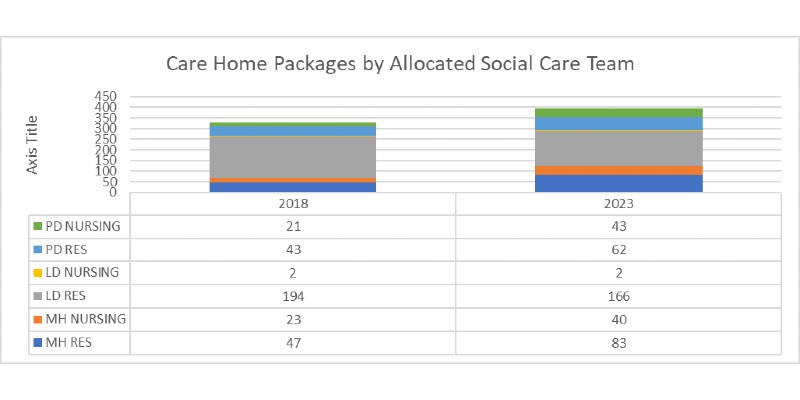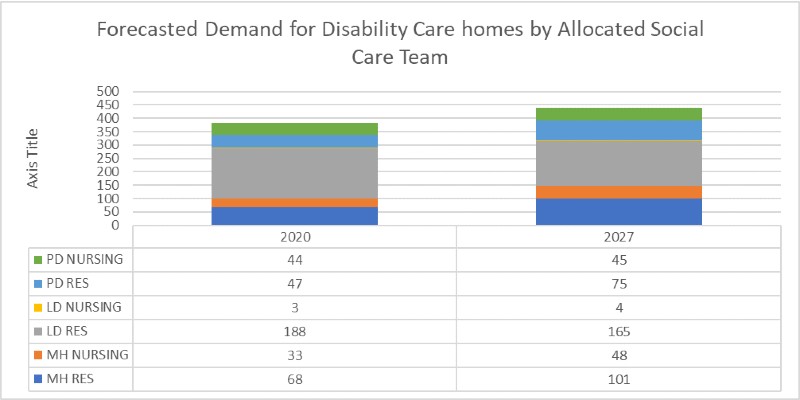Current capacity and forecasted demand

Mental health provision
The number of clients receiving WCC funded packages has shown a substantial increase over the five-year period. In residential care, the number of clients increased from 47 in April 2018 to 83 in April 2023, reflecting a 77% rise. In nursing care, the number of clients increased from 23 in April 2018 to 40 in April 2023, indicating a 74% increase.
Learning disabilities
For service users with learning disabilities, the trend has been different when compared to service users with mental health illnesses, with a decrease in the number of clients receiving WCC funded packages of residential care due to an increased focus on supported living provision. In residential care, the number of clients decreased from 194 in April 2018 to 166 in April 2023, representing a 14% decline. In nursing care, the number of WCC funded clients remained unchanged at 2 clients in both April 2018 and April 2023.
Physical disabilities
For people with physical disabilities, the number of individuals receiving WCC funded packages increased over the five-year period. In residential care, the number of residents increased from 43 in April 2018 to 62 in April 2023, marking a 44% rise. In nursing care, the number of clients increased from 21 in April 2018 to 43 in April 2023, indicating a significant 105% increase.
| Package | April 2018 | April 2019 | April 2020 | April 2021 | April 2022 | April 2023 |
|---|---|---|---|---|---|---|
| Mental health | 11 | 11 | 14 | 16 | 13 | 18 |
| Learning disability | 3 | 4 | 5 | 4 | 4 | 5 |
| Physical disability | 1 | 2 | 2 | 2 | 2 | 3 |
| Total | 15 | 17 | 21 | 22 | 19 | 26 |
| Package | April 2018 | April 2019 | April 2020 | April 2021 | April 2022 | April 2023 |
|---|---|---|---|---|---|---|
| Mental health | 0 | 1 | 5 | 9 | 8 | 6 |
| Learning disability | 0 | 1 | 1 | 0 | 0 | 0 |
| Physical disability | 0 | 3 | 4 | 4 | 3 | 3 |
| Total | 0 | 5 | 10 | 13 | 11 | 9 |
Out of county placements are when people who need social care services are placed in a different local authority area than the one, they live in or are from. There are different reasons for out of county placements, depending on the type and level of care needed, the availability and quality of local services, and the preferences and well-being of individuals.
The table above shows the number of out of county placements for residential and nursing packages for 18 to 64-year-old care homes in Warwickshire from April 2018 to April 2023. The highest number of out of county placements for both residential and nursing packages of care were made for mental health service users. Because of this we will continue to work with our providers to ensure that we have sufficient local residential specialist beds to meet the needs of our population.
Future demand

The graph above shows the projected demand for 18-64 care beds in Warwickshire by service need from 2020 to 2027. Both nursing and residential beds are expected to increase in demand, with overall nursing beds rising by 13% and overall residential beds by 21%. Physical disability and mental health have the highest growth rates for nursing beds, while mental health has the highest growth rates for residential beds.
Learning disability is the only disability type with a projected decline in residential bed demand. No disability type has a projected decline in nursing bed demand.
The impact of the COVID-19 pandemic has presented us with a challenge estimating future trends, due to significant drops in occupancy levels during the pandemic and then increased levels of demand over the last 12 months after restrictions were lifted in March 2022. Because of this we will continue to gather information and intelligence regionally and nationally and work with providers to understand trends in demand and we will be engaging with our local providers to come to a view regarding the right level of investment and development for our market through provider forums and mutual aid calls.
Understanding demand - location need
| Beds | North Warwickshire | Nuneaton and Bedworth | Rugby | Warwick | Stratford |
|---|---|---|---|---|---|
| Beds per 1000 (18 to 64 years age group) | 1.88 | 1.5 | 0.69 | 0.73 | 0.88 |
| Percentage of admittable vacant beds (from NHS capacity tracker - 13 November 2023) | 12.5% | 12.5% | 4.26% | 5.97% | 4.48% |
| Beds | North Warwickshire | Nuneaton and Bedworth | Rugby | Warwick | Stratford |
|---|---|---|---|---|---|
| Beds per 1000 (18 to 64 years age group) | 0 | 0.25 | 0.1 | 2.11 | 0.11 |
| Percentage of admittable vacant beds (from NHS capacity tracker - 13 November 2023) | 0% | 0% | 0% | 6.7% | 0% |
Sources:
- For beds per 1000 18-64 years age group - Warwickshire population data
- For percentage of admittable vacant beds - data downloaded from NHS Capacity Tracker on 13 November 2023 and divided by total number of CQC registered beds.
While the average number of vacant beds suggests sufficient supply to meet demand, the current supply and demand varies considerably across the county in terms of bed capacity. Comparing information on vacancies with demand and the size of the local population, it is apparent that for residential bed provision North Warwickshire and Nuneaton and Bedworth have more beds per 1000 of the 18 to 64 population than other districts and boroughs, and a higher percentage of vacant beds.
We are also seeing similar trends for nursing provision. North Warwickshire, Nuneaton and Bedworth, Stratford and Rugby supply is more limited with these areas having a notably lower number of beds per 1000 of the 18 to 64 population when compared to Warwick, which has the highest percentage of vacant beds in comparison to those districts and boroughs.
Self-funders in People with Disabilities Care homes adds complexity to the challenges of forecasting future demand for services faced by local authorities. These individuals privately pay for their care instead of relying on government-funded support and the challenge arises from factors including a lack of reporting. This complexity can significantly impact our ability to predict future demand accurately and ensure that Warwickshire's care market possesses the necessary capacity.
To address this, we are committed to fostering collaboration with care providers. Through close cooperation, we aim to enhance our understanding of the self-funder population within our region and work with providers to shape the market to meet needs.
Care home provision in Warwickshire
| Rating | North Warwickshire | Nuneaton and Bedworth | Rugby | Warwick | Stratford |
|---|---|---|---|---|---|
| Number of locations | 11 | 18 | 5 | 8 | 10 |
| Number of CQC registered beds | 72 | 120 | 47 | 67 | 67 |
| CQC rated 'Outstanding' | 0 | 0 | 0 | 0 | 0 |
| CQC rated 'Good' | 9 | 12 | 5 | 7 | 8 |
| CQC rated 'Requires improvement' | 1 | 3 | 0 | 1 | 2 |
| CQC rated 'Inadequate' | 0 | 1 | 0 | 0 | 0 |
| CQC not yet rated | 1 | 2 | 0 | 0 | 0 |
| Rating | North Warwickshire | Nuneaton and Bedworth | Rugby | Warwick | Stratford |
|---|---|---|---|---|---|
| Number of locations | 0 | 1 | 1 | 7 | 1 |
| Number of CQC registered beds | 0 | 20 | 7 | 194 | 8 |
| CQC rated 'Outstanding' | 0 | 0 | 0 | 0 | 0 |
| CQC rated 'Good' | 0 | 1 | 1 | 5 | 1 |
| CQC rated 'Requires improvement' | 0 | 0 | 0 | 2 | 0 |
| CQC rated 'Inadequate' | 0 | 0 | 0 | 0 | 0 |
| CQC not yet rated | 0 | 0 | 0 | 0 | 0 |
Source - Care Quality Commission, Care Directory with filters – October 2023
The majority of locations across the county were rated 'good' with one home in Nuneaton and Bedworth being rated as ‘inadequate’ and a further nine across all district and boroughs being rated as ‘requires improvement’.
Alongside our commitment to quality, our Commissioning and Quality Assurance teams continue to collaborate closely with residential care providers through ongoing communication, visits and access to training to support providers to improve quality of their services.
We will continue to work closely with our social care providers to drive quality improvement through our ‘See, Hear and Act’ approach through which we gather and triangulate intelligence from multiple sources to identify any quality themes or concerns. Where concerns are identified we undertake quality assurance activity to understand these in more detail and this could include a visit to the provider to validate the intelligence.
Where necessary support improvements through Service Improvement Plans (SIP). Significant concerns are escalated to Service Escalation Panel (SEP) where remedial actions are discussed, agreed and monitored. Remedial actions could include restrictions on admissions to the service until sufficient improvements have been evidenced and sustained. This could be a Voluntary Placement Stop (VPS) where the provider agrees to restrictions on admissions and enables them to have the resources to implement improvements as identified in the SIP.
This collaborative approach benefits the service users whilst building supportive partnership with the providers.
Changes in disability care home provision January 2017 to December 2023
| District or borough | Number of new beds | Number of closed beds | Change |
|---|---|---|---|
| North Warwickshire | 16 | 15 | 1 |
| Stratford | 0 | 12 | -12 |
| Nuneaton and Bedworth | 32 | 8 | 24 |
| Warwick | 0 | 30 | -30 |
| Rugby | 16 | 15 | 1 |
| Warwickshire | 64 | 80 | -16 |
| District or borough | Number of new beds | Number of closed beds | Change |
|---|---|---|---|
| North Warwickshire | 0 | 0 | 0 |
| Stratford | 0 | 0 | 0 |
| Nuneaton and Bedworth | 20 | 0 | 20 |
| Warwick | 0 | 0 | 0 |
| Rugby | 0 | 0 | 0 |
| Warwickshire | 20 | 0 | 20 |
Source: CQC database as of 1 December 2023
There has however, been an increase in nursing beds in Warwickshire compared to residential beds which have seen an overall reduction of 36 beds compared to an increase of 20 new nursing beds. The increases in nursing beds can be seen in Nuneaton and Bedworth with the biggest decrease in residential beds being found in Warwick. Overall, Warwickshire has seen a net decrease of 16 beds with 64 new beds and 80 closed beds.